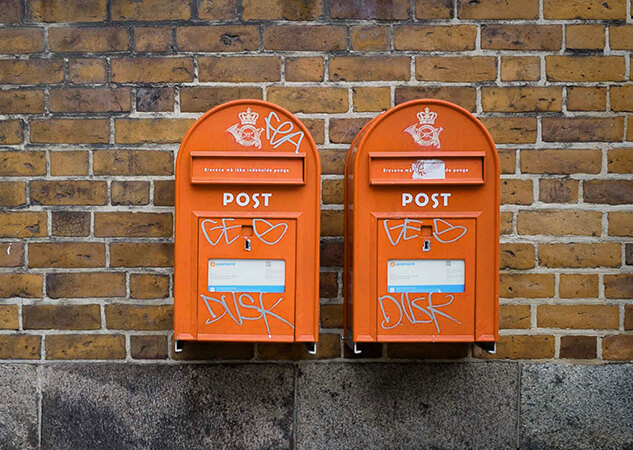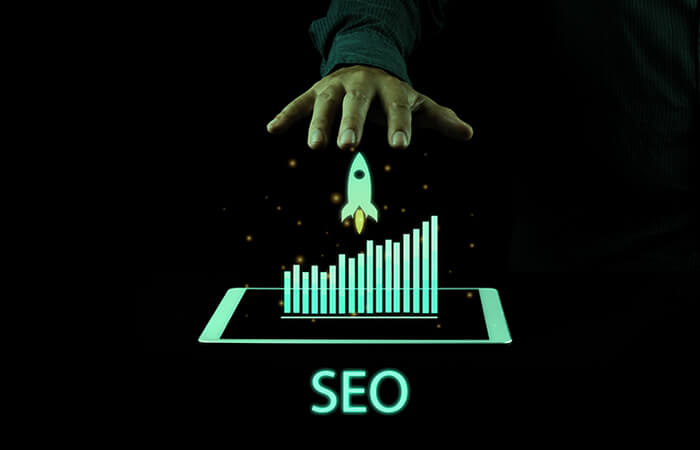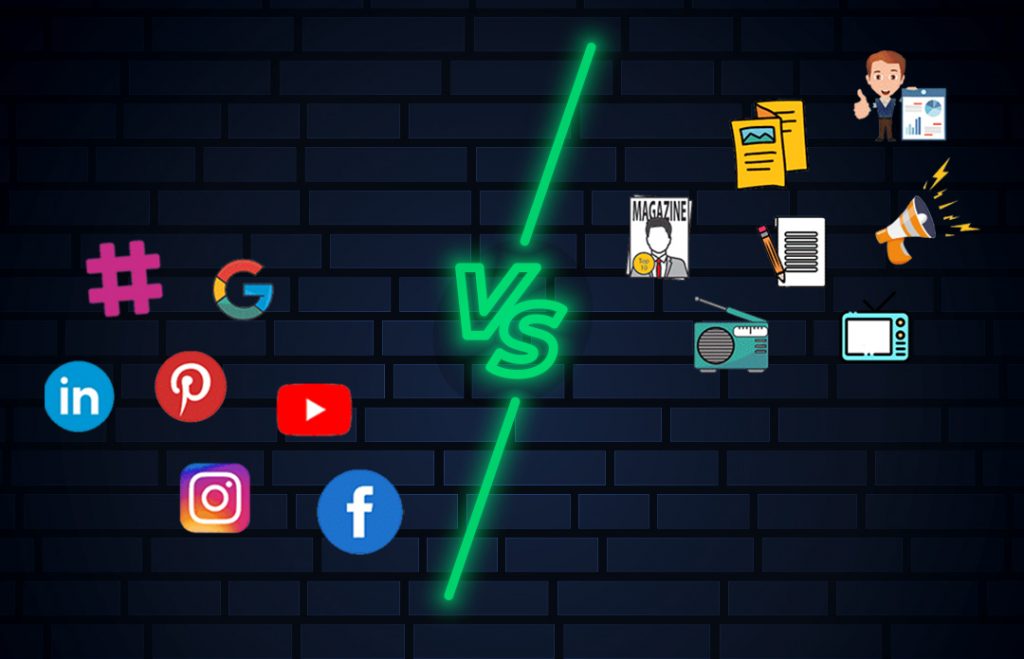There’s a civil war right now, and it’s digital marketing vs. traditional marketing. Some quarters would argue that traditional marketing paved the way for digital marketing. In this regard, its reliance on physical materials to push sales became archaic.
Digital marketing became the sales industry’s response to technology’s forward march. Newspapers and radios became emails and phone apps. This factor brought the global digital marketing revenue to $496.08 billion.
Despite this figure, there’s still a credible preference for traditional marketing. This decision is because of how it reaches customers more personally. Does this give it an edge in the market, or will digital marketing finally seize complete control?
This article hopes to uncover which marketing type is more effective, and by the end, you’ll have your answer.
What is Traditional Marketing?
Ever seen an advert on a billboard? There you have it. Traditional marketing refers to sales or ad campaigns that happen offline. This type of marketing was the sole method of advertising products/services for decades. That is until the internet came in with all its superpowers.
By using TV commercials, and flyers, traditional marketing was able to reach customers. However, critical effectiveness lies in the ability to establish a physical presence in the minds of individuals. This realization gave all adverts a mental visual stamp using the traditional marketing method.
Additionally, target audiences were never out of reach. This reality was because promotional materials were easy to get. The linchpin of traditional marketing is experience personalization.
This factor means that marketing initiatives, in most cases, target individuals. It’s a better strategy instead of targeting an entire group that sometimes hits and misses.
Also, different channels and elements serve as drivers to achieve varying results. These include;

These beautiful pieces of paper information have proven effective over the years. Written content like newspapers can reach 20-30 pages. This structure makes it possible for readers to get information at a minimal cost.
Print materials like newspapers also guarantee the generation of actual conversations. For instance, one reader sees a headline that catches their fancy. They proceed to tell another in passing. This means you can distribute adverts in the newspaper through word of mouth.
Additionally, print gives readers a feeling of trust. According to essential research, 55% of consumers update from printed newspapers. This figure points to the fact that newspapers offer a high level of information. It’s also the reason why most brands include their adverts in newspapers. It builds trust from customers.
Broadcast

Broadcasts have grown by relying more on televisions and radios to share information. This method aims to use radio and television broadcasts to get customers’ attention.
To guarantee effectiveness, the product or service provider only makes the broadcasts. This strategy is because any other system would get redundant. In addition, listeners will tune out if things go south.
Broadcast marketing is more fluent than its counterparts as it’s adaptable. For instance, it’s accessible to slot advertising content between Netflix shows and YouTube videos. The viewer also loses nothing as the ad runs for a few seconds. After that, you can return to the scheduled show.
Direct Mail

Recall the era when post offices were everywhere? Great. These establishments also functioned as traditional marketing machinery. Print materials like postcards and letters get to potential receivers in this case.
Direct mail can get to individuals who have shown interest in the company’s product or service. This method happened by way of subscriptions. For this method, emotions played a huge role, not in the wrong way.
It was the preferred marketing tool for non-profit or fundraising organizations. This situation existed because it allowed them to establish a physical connection. In turn, donations would occur based on emotions drawn from the person.
Event Marketing

If the company has a lot to showcase, safe to say it happens in the open. Event marketing creates a platform for companies to display products and services. In this case, an organization will host an event, conference, or convention. This program is where advertising materials will be on display.
The reason for its popularity amongst companies is its interactive feature. Prospective customers can visit any booth of their choice and get first-hand experience of products. If executed right, the customer decides to patronize.
Large signs and banners are what companies prefer when trying to draw attention. However, sporting and charity events provide another opportunity for brand recognition.
Referral Marketing

Still one of the famous traditional marketing methods in use today. The success of referral marketing is customers telling others about their experience of a company. New customers have no reason to doubt where the reviews come from with this method.
It’s easy for companies to cultivate these reviews. This is through referral programs that give discounts and special offers. Company privileges like these encourage more people to share experiences.
Telemarketing

Telemarketing ushered in a new sales phase in the 1970s with a reliance on technology. For enterprises that rely on telemarketing, the tools of the trade include fax and phones. It enables businesses to interact with customers in a bid to make sales.
Telemarketing became a preferred business method because of its direct marketing nature. This shift was due to its instant response feature. A customer’s question gets an immediate response. This allows customers to save time and the company to build trust.
Despite its obvious advantages, this system of marketing has its flaws. For instance, the telemarketing sales rule requires the disclosure of crucial information. It also limits the number of times marketers can call consumers. With these in play, it’s no wonder the strategy has a 2% success rate which serves as a warning sign for marketers.
What is Digital Marketing?
A deviation from traditional methods, digital marketing is an A-list sales essential. The term refers to any form of marketing that happens online. With social media and search engine optimization tools, audience reach becomes global.
The perk of digital marketing is the instant access it gives businesses to get their message through on a global scale. Using Facebook and Twitter, brands can convert account followers into customers. This assertion explains why Tiktok, for instance, has an ad revenue projection of $5.96 billion.
This sales method also guarantees you get more clients—platforms like Listed offer business listing and review services. If a company has a valuable product, access to over 4.62 billion active internet users is sure.
Talking about digital marketing has piqued your interest. Here are some of its mainstream elements;
Social Media Marketing

If you’re targeting the younger generation, this strategy is ideal. There’s a new platform for social interaction popping up every day. With the curiosity factor on a high, businesses open more social accounts, ensuring that they don’t miss a part of their targeted audience.
Using social media platforms for marketing is also easy to put in place. For example, regular content posts on an Instagram account to build a following. Then, if you’re able to keep giving value, followers will also check out your product or service.
Engagement is also a huge determinant of your sales success. Find out what works best on the platform you choose to get going. Twitter works best for written posts, and Instagram is perfect for pictures. Facebook is ideal for long-form articles, while TikTok thrives on videos. You can also mix content styles to meet content preferences.
Email Marketing

This channel is a by-product of multiple subscriptions to updates and newsletters. Email marketing involves sharing information directly to a user’s email address. Users have already visited a blog or company page for a particular product or service in most cases. They find helpful information and subscribe to an email list to learn more.
When this happens, the user gets daily, weekly or monthly newsletters. This comes from a company or individual and provides offers and updates on services. With enough information, you can get all the data on the company and become a regular customer.
Businesses have realized that the key here is to keep customers interested. This fact is because the email platform itself is perfect for work information. In truth, it’s challenging to think of it as anything but a business media page.
Creating content that can encourage interactions is mandatory. For example, the written text goes with pictures and short videos to make email marketing campaigns enjoyable.
Search Engine Optimization

SEO – The lifeblood of ranking articles and content value. Search engine optimization is every article, video, or image that pops up on google’s first page. It requires keywords, optimized headings, meta descriptions, and some technical elements. Together, these elements boost the content to top SERPs and get enough visibility.
For marketing purposes, SEO plays a significant role in content creation. For example, businesses write articles to discuss their products and services. This information would lay out of reach to users on whatever platform it gets published. Using SEO to optimize the content makes it easier to locate on search engines like google.
Search engine optimization begins by finding keywords opposing businesses rank for. These phrases are crucial in creating your unique content. The content will, in turn, be a solution to users’ questions. But, avoid keyword padding as this sacrifices content value.
Affiliate Marketing

Have you ever seen a youtube content creator mention a product or service as a sponsor? Good. That’s the basis of the affiliate marketing model. It requires companies to recruit celebrities or influencers. These people, in turn, push a product to the general public.
The influencer can choose to integrate the advert as part of their daily content. The individual can also dedicate a specific post to the business. The industry is rising, with expectations to reach a valuation of $12 billion this year.
Affiliate marketing relies on the personality and fan base of the influencer. If there’s any controversy, it could end in a loss for the brand they’re marketing for.
PPC Marketing (Pay-Per-Click)

This involves the use of paid adverts to generate sales. A company pays a certain amount of money to the search engine for every click on its ad. It’s a perfect model for building an audience, and the fee is of no consequence. This fact is because you’ll be earning more from business patrons.
What sets this method apart is its timeframe. Once the payment stops, the ad stops running. This is irrespective of whatever campaign plans you’ve already made. This makes it an absolute need to plan your marketing according to your budget.
Di Digital Marketing vs. Traditional Marketing – The Difference
At the moment, these systems have a lot to offer. This makes it hard to pick which one’s better. Let’s turn the debate over traditional marketing vs. digital marketing into comparison to make things easier.
Interaction With Customers
In this case, traditional marketing comes with a peculiar advantage. It lets you connect with your local audience. However, you can’t corner the local market and build a solid base for future marketing campaigns. This situation happens by getting personal with the locals. They interact with your business as they already get the complete picture.
But, digital marketing creates an opportunity for brands to trade globally. It’s also a lot easier to track sales and interaction metrics. You’ll get accurate details on how much the client knows.
Freedom of Tweaking Your Ads
Considering its physical attributes, there’s difficulty in adjusting traditional marketing systems. For example, imagine an error on a printed flyer that’s already been sent. There’s no way to recall all the papers, and if a new batch gets out, they will be complete.
You’re only required to take down a planned upload for digital marketing. It’s easy to handle with ai tools that schedule posts.
Cost Effect
For the cost, traditional marketing suffers a huge blow. This negative is because physical adverts need space. For that, it requires platforms like newspapers and billboards. This causes brands to spend $150 on broadcasting and $200 on newspapers.
That figure might seem fair, only it isn’t. Digital marketing doesn’t need brands to occupy any actual location. In most cases, campaigns happen on social media and can cost marketers $75 on marketing. That makes it a shoo-in for brands on a tight budget looking for effectiveness.
The Key Revenue Driver
For traditional marketing, revenue drivers boil down to methods that guarantee interaction. For example, conferences and direct mail provide access to customers, which results in revenue generation.
Social platforms are a huge success determinant for digital marketing. It allows brands to share information at incredible speeds. Additionally, customers get the assurance that the company isn’t far away if they need to learn more.
Campaign Measurement
To assess the effectiveness of a physical marketing campaign, brand surveys are essential. This method requires the brand in question to carry out a study using a focus group. The group will represent their client base for a particular product or service for the study. Coupon codes are an alternative to assess customers if surveys are not practical.
Campaign assessment for digital marketing is very different. Instead of dealing with people, you’re presented with figures. These metrics come from social media pages and websites which your brand has. Analyzing page views and online traffic, you understand customer behavior and preferences.
Pros and Cons of Traditional Marketing
Pros
The perks of traditional marketing include the following;
Access To Local Audience
Sure, we’ve talked about this before, but it’s incredible. You can influence what customers in your location buy. With the right TV commercials and billboards, interest will get raised. Additionally, you’re more relatable as local clients find you less corporate.
More Accessible to Process and Recall
A factor that has plagued the advertising industry is mental retention. This issue means it’s difficult for the general public to remember what they’ve seen. After consuming volumes of information, it’s not surprising they forget marketing content.
Traditional Marketing solves this issue. However, it’s hard to forget an advert if the flyers are still within reach.
Ideal for Older Audiences
Do you need a way to reach the older demographic? Try TV and newspapers. Reports show that audiences above 50 spent double the time on these mediums. This figure dwarfs those spent by ages 12-34.
Cons
Despite these brilliant advantages, the system does have its flaws;
Uncertainty of Reception
You could spend money printing paper for a particular campaign and get no reception. This negative happens because the customer has no interest in the product. So, in the end, you’re left with print material and no customers.
Late Data Delivery
It takes a long time to get feedback on your marketing campaign. This delay means you’ll experience difficulty in changing strategies. Also, you can’t get statistics unless the customer initiates it.
Popularity Decline
Most brands have opted for online systems, and customers have followed suit. This movement means there’s less interaction with traditional marketing channels.
Pros and Cons of Digital Marketing
Pros
Digital Marketing makes a strong argument for top advertising channels with these assurances;
Reach
As it’s digital, brands can reach more people on the internet.
Cost-Effective
Digital marketing works regardless of your available budget. So you can use this system to meet your marketing goals if you’re running a start-up. The best part is the account won’t go into the red.
Instant Conversions
Using social media uploads and blog posts, you can get immediate responses.
Cons
The drawbacks of this system include the following;
Fast-Changing
Nothing is set in stone in the digital space, which applies to marketing. As a result, it becomes a difficult task to keep up with trends and tools.
Increased Competition
You’re pushing products globally, so similar brands target the same customers.
Preparation Time
With so many factors to consider, it gets time-consuming. In addition, staff training is also tedious for ad campaigns.
Also Read: How Do You Set Up SMART Marketing Goals For Your Business?
Digital Marketing vs. Traditional Marketing – Which Has Got the Edge?
It’s hard to choose between digital marketing vs. traditional marketing. The latter has made its mark in industries that need a physical presence. However, tech companies have found it more effective to showcase products in person. This presentation gives customers a first-hand experience of what to expect.
But, digital marketing brings a speed factor. In the entertainment industry, promotion is easy with trailers and short videos. This creates all the anticipation you need from online quarters. Platforms like Netflix have also cracked the advertising market. This success is by using 15-second video ads on Youtube. As a result, information gets across without overwhelming the prospective customer.
With this match-up, it’s hard to see which one moves in front. The debate over digital marketing vs. traditional marketing comes down to the target audience and strategy intention. In truth, it’s more practical for both systems to pair up despite their apparent similarities.
Digital Marketing vs. Traditional Marketing: Can They Work Together?
A very frequent question people raise when debating digital marketing vs. traditional marketing is can they work together? The one-word answer is, Yes. This fusion is possible. But, you’d have to consider various factors. For example;
- Target Audience
- Industry
- Marketing Budget
Digital Marketing vs. Traditional Marketing: Where to Invest?
Best not to put your eggs in one basket. It will only leave you with rotten ones in the end. Therefore, it’s better to research digital marketing vs. traditional marketing before investing in both.
You may also find this interesting: Discover 8 Types of Digital Advertising to Grow Your Business
Conclusion
With this article, we’ve put in place our version of the ever-going debate on digital marketing vs. traditional marketing. You can choose to combine them or go with one option for your business.
However, the world is evolving rapidly, and people are adapting to it. In this ever-changing realm, digital marketing has proven itself as the most effective form of advertising, way more than traditional marketing. With the right digital marketing services provider, you’re bound to hit high revenue numbers.
Schedule your 15-min Discovery Call to turn your business into the next big brand that people remember.


